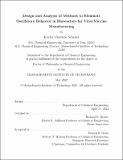Design and Analysis of Methods to Eliminate Oscillatory Behavior in Bioreactors for Viral Vaccine Manufacturing
Author(s)
Schickel, Kaylee Christine
DownloadThesis PDF (1.346Mb)
Advisor
Braatz, Richard D.
Terms of use
Metadata
Show full item recordAbstract
Continuous stirred tank reactors, or CSTRs, are one of the most commonly used reactors in the biomanufacturing sector. This is because CSTRs offer a relatively simple design, operate by maintaining a constant and predictable outlet concentration, and have been utilized and studied long enough for the field to have developed a great familiarity. One major drawback of single-CSTR applications arises with certain cell-virus systems that exhibit the von Magnus effect. Through the von Magnus effect, oscillations in cellular and viral states arise with individual states sometimes spanning orders of magnitude within a single run. This work demonstrates two successful methods for reducing and eliminating this periodicity including designing and applying a proportional feedback controller for setpoint tracking as well as staging multiple CSTRs in series. Additionally, oscillatory behavior can be avoided through novel reactor designs. One such design, a novel hollow fiber bioreactor, is explored in this work. This design constrains larger cellular and viral species within a hollow fiber lumen where viral infection of the cells can take place along the length of the reactor. Fresh media is provided to the system through the extracapillary space with smaller waste and nutrient molecules able to pass through the membrane to maintain the health of the cells. With this design, we are able to achieve stable outlet concentrations that can be optimized. Finally, as an extension to these ideas, population balance models were analyzed to allow the tracking of individual populations of cells within a reactor - particularly those of a certain age group. As cells age, they may become less productive or more likely to exhibit genetic decomposition. Thus, tracking cell ages provides avenues to design new systems that may be able to filter such aging cell populations out, thereby potentially increasing the overall productivity of the system. The groundwork for this is providing solution strategies for population balance models including numerical approaches as well as direct analytical solutions. Both approaches are analyzed here in great depth.
Date issued
2022-05Department
Massachusetts Institute of Technology. Department of Chemical EngineeringPublisher
Massachusetts Institute of Technology